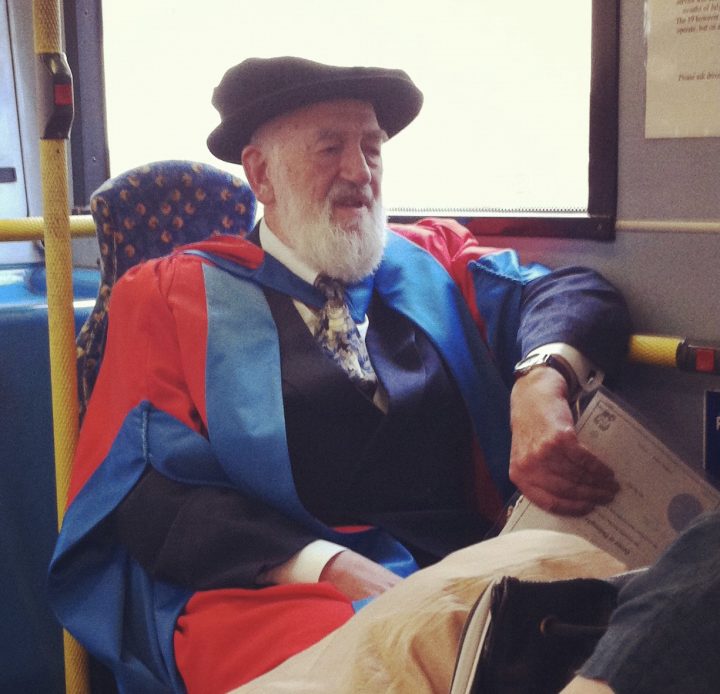
I took this photo of Roy Thomson in 2013. He had just been awarded a PhD by the University of Northampton for a thesis entitled “The role of leather science and technology in heritage conservation”.
Sadly he passed away on Monday 14th June 2021. He had completed the leather degree at Leeds University some nine years before me and in 1968 he was appointed to the position of Works Director at the Wellington Tannery Division of the famous Strong & Fisher Ltd, a world leader in sheepskin garment leather. .
In 1993, Roy became chief executive of the Leather Conservation Centre bringing with him a wealth of leather knowledge and scientific understanding to leather conservation.
In 2003, as he was about to retire from that role he asked me to become a Trustee and I have been involved since. It has been a really rewarding role. He continued for some years talking about leather history and technology at the Conservation Centre’s courses and also became closely involved in the Archaeological Leather Group, as well of course as doing his PhD. A few years ago he stepped back from teaching at the courses and I took over. I have essentially used his material with minor adaptations since.
With no course in 2020 we start again in October 2021 with our regular course at West Dean College near Chichester, West Sussex so I decided to update the documentation and have spent a few days going through it while hiding out in northern Scotland. It talks about how hides and skins were important as soon as pre-humans started to walk on two legs and move about as it was the only sheet material available millions of years ago. They did not have the teeth common in other carnivores required to break through thick skin so their regular, as opposed to opportunistic, access to the meat needed in their varied diet only came later when they had learned how to make tools that could cut through and clean hides and carcasses.
The earliest creature which appears to have made this breakthrough, and with it the systematic use of animal skins was Australopithecus Habilis who roamed East Africa some two million years ago and seems to have developed a diet in which meat played an increasingly significant part.
The next stage in the development of the use of hides and skins is associated with the Pithecanthropoid group of hominids. These creatures were systematic and successful hunters. They had learned to control fire and cooked their meat. They had also developed a wider range of tools including the typical Acheulean coup-de-point which has been shown to have been used for both butchering and skinning.
Some bands of these Pithecanthropoids lived in large tent like shelters constructed by spreading skins over wooden frameworks, supported by rows of upright poles. Skins also appear to have been used to make rough bundles running along the sides of the shelters. A fire in a central hearth warmed these dwellings. With such a structure, the curing effect produced by drying out skins slowly would have been demonstrated. More importantly, the mild tanning action of wood smoke would also have manifested itself. The suggestion that Pithecanthropus Erectus observed these changes is supported by the fact that they devised special stone implements for scraping away the unwanted fat and flesh. This scraping would have distributed the fats throughout skins giving a more supple product. Flexing the pelt while it was drying out would also have given a softer product. It is very possible that a crude form of leather was being produced by these hominids over a million years ago.
These facts were all researched by Roy and form the basis of a wonderful story of leather that goes back much further than the few thousand years that is normally understood. Hides and skins in raw, “leathered” and fully tanned form have played a vital role in this planet for more than a million years. Durable, sustainable, versatile and circular with integrity.
Mike Redwood. 21st September 2021